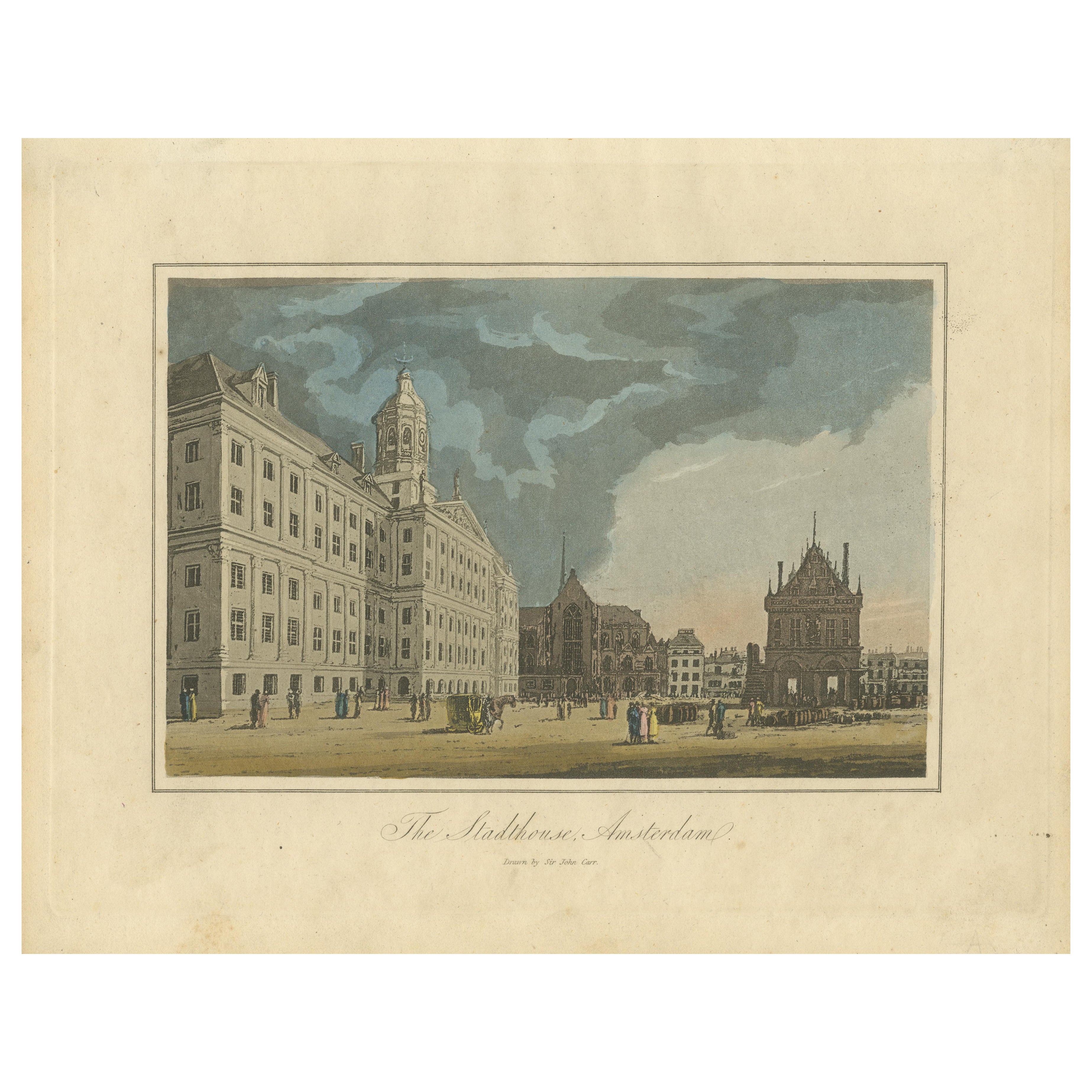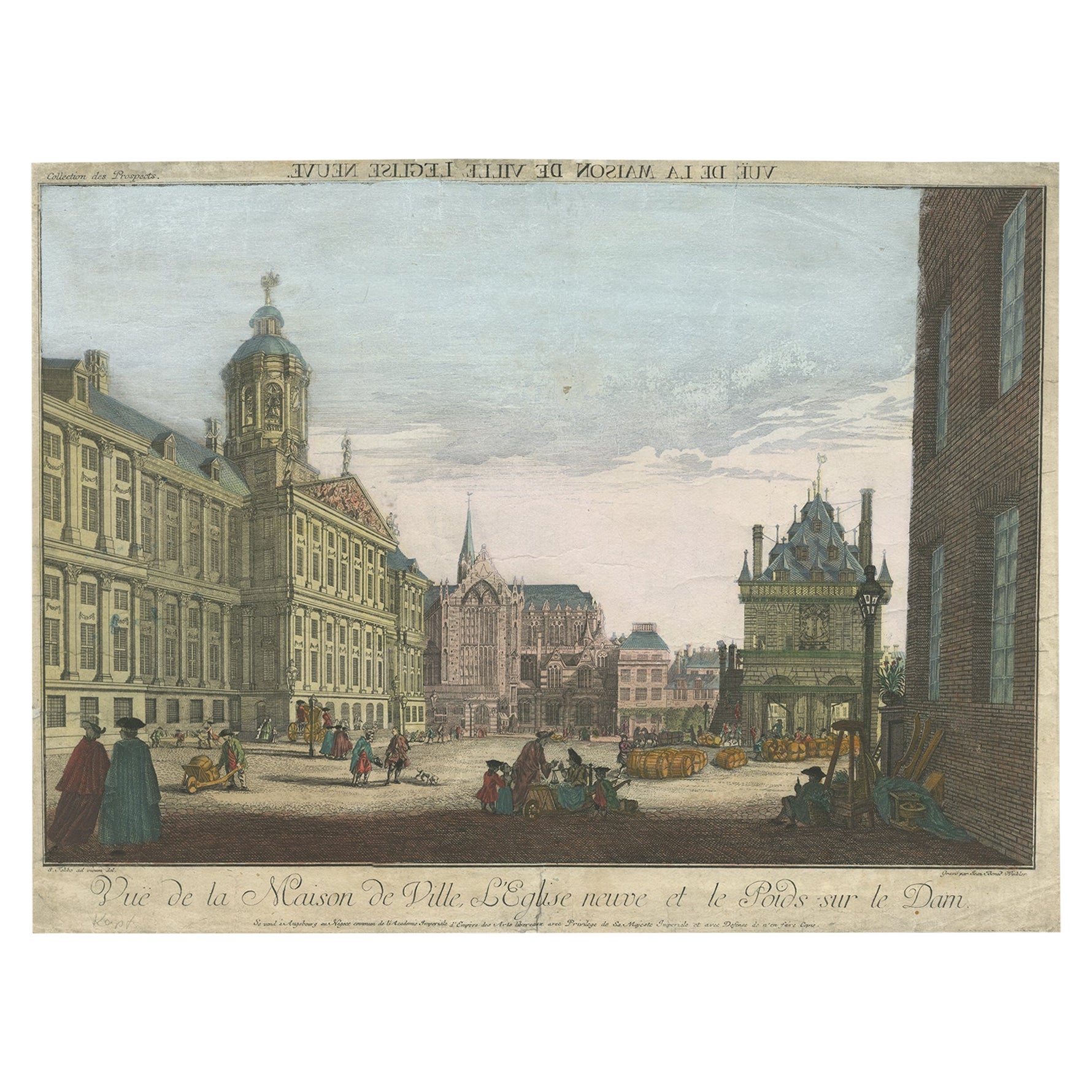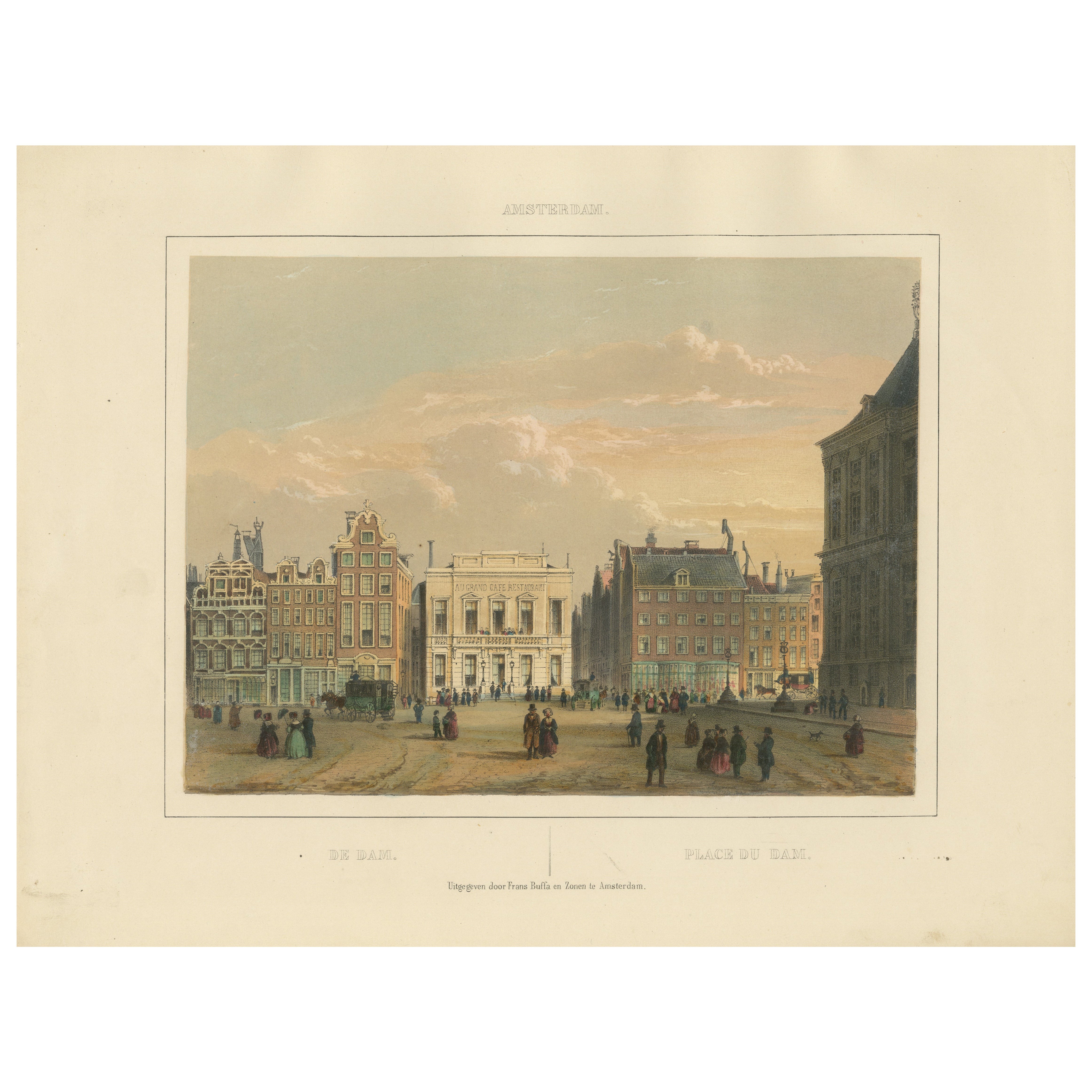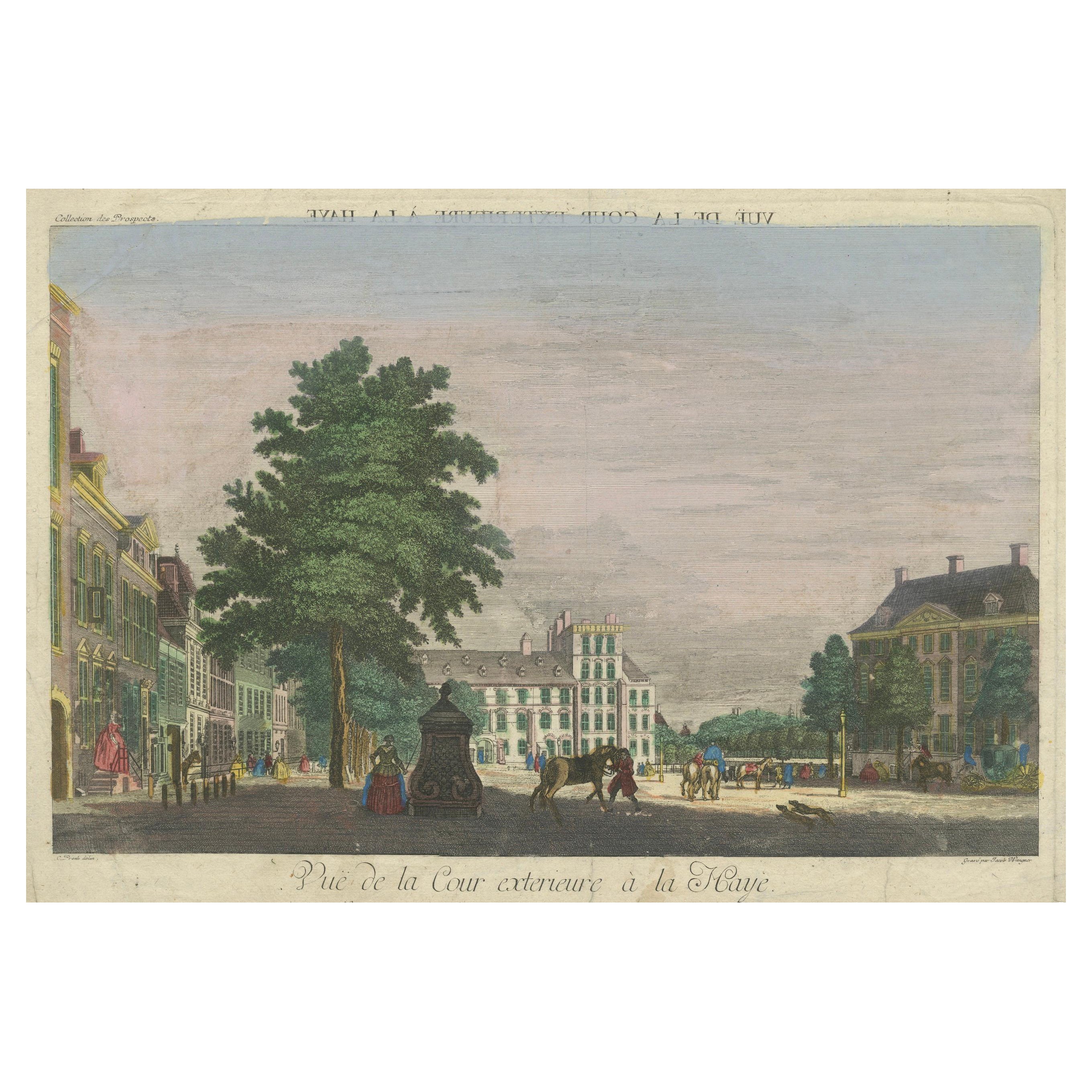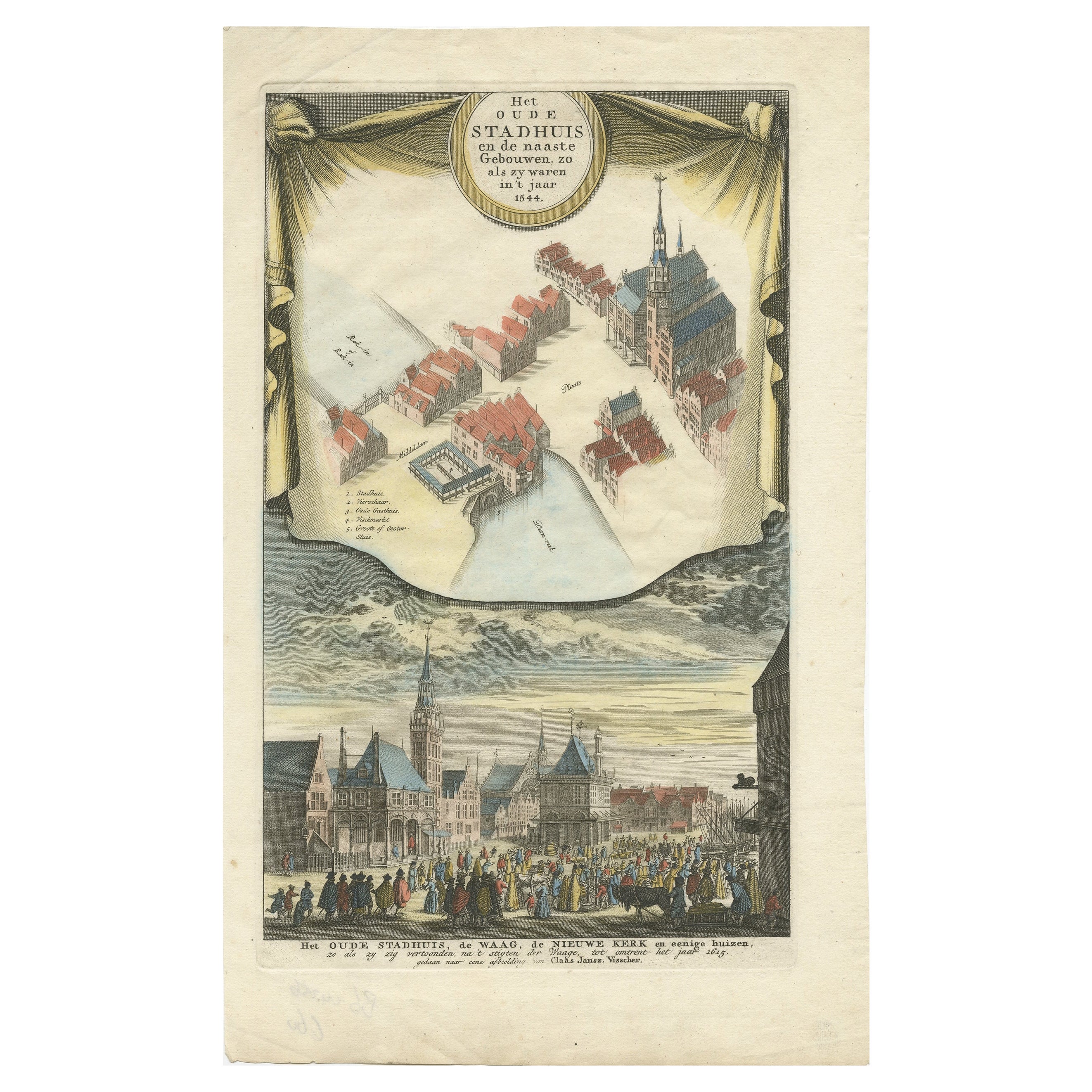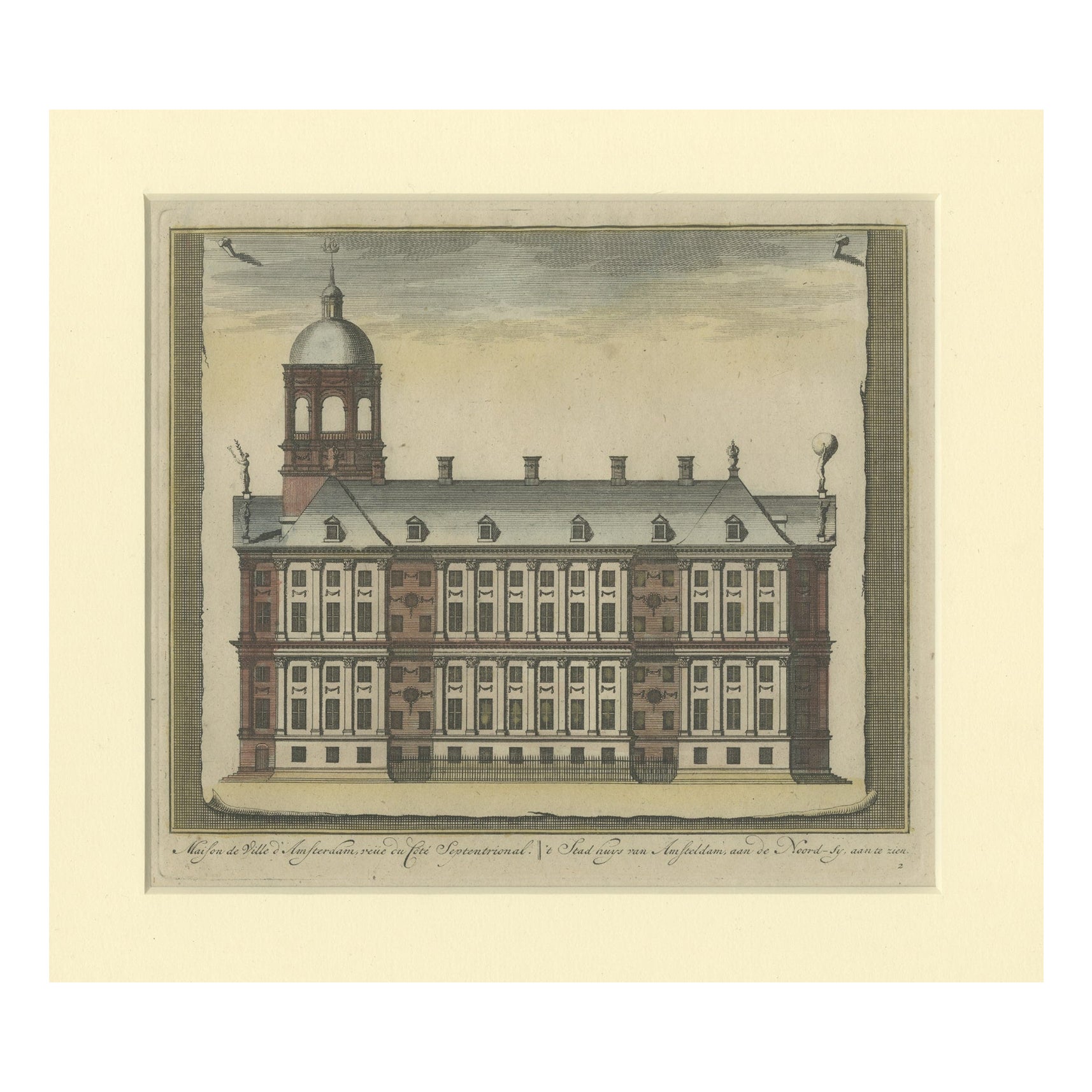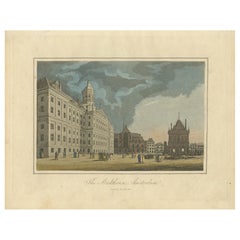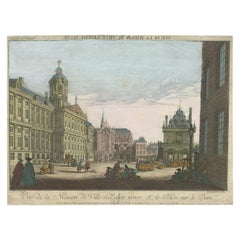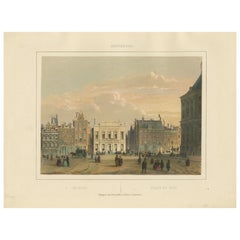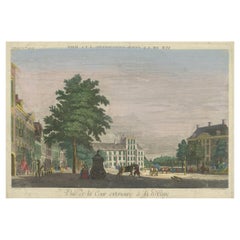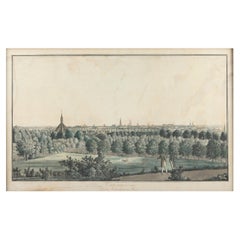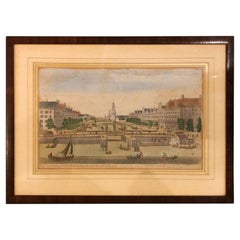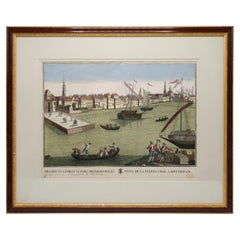Items Similar to Hand-Colored 1765 Engraving of Amsterdam Royal Palace and Dam Square, 1765
Want more images or videos?
Request additional images or videos from the seller
1 of 6
Hand-Colored 1765 Engraving of Amsterdam Royal Palace and Dam Square, 1765
$364.24
$455.2920% Off
£271.10
£338.8720% Off
€304
€38020% Off
CA$498.91
CA$623.6420% Off
A$554.90
A$693.6220% Off
CHF 289.75
CHF 362.1920% Off
MX$6,752.53
MX$8,440.6620% Off
NOK 3,700.56
NOK 4,625.7020% Off
SEK 3,470.47
SEK 4,338.0920% Off
DKK 2,314.25
DKK 2,892.8120% Off
Shipping
Retrieving quote...The 1stDibs Promise:
Authenticity Guarantee,
Money-Back Guarantee,
24-Hour Cancellation
About the Item
This hand-colored engraving, titled "Het Stadhuis van vooren," depicts the Amsterdam Royal Palace (initially the Town Hall) in the mid-18th century. Created in 1765 by Frans de Bakker after a drawing by Reinier Vinkeles, the print showcases the palace as a symbol of Amsterdam's wealth and power during its Golden Age.
The Royal Palace is presented in a classical architectural style, reflecting the design principles of the ancient Greeks and Romans. The palace was considered an architectural marvel at the time, often referred to as the "eighth wonder of the world" due to its grandeur and symmetry. It was designed by Jacob van Campen and completed in 1655, initially serving as the city hall. The building was constructed on 13,659 wooden piles and featured extensive classical elements, symbolizing a microcosm of the universe.
In the foreground, the lively Dam Square is depicted with various figures, including merchants, porters, and well-dressed citizens, illustrating the bustling urban life of 18th-century Amsterdam. Notable landmarks such as the Waag (Weigh House) and the Nieuwe Kerk (New Church) are also visible, adding to the historical and architectural context of the scene.
This engraving not only captures the architectural splendor of the Royal Palace but also provides a glimpse into the daily activities and social dynamics of the era. The detailed representation of the people and their interactions on the Dam Square reflects the economic and cultural vibrancy of Amsterdam during this period.
The engraving "Het Stadhuis van vooren" was created by Frans de Bakker, a notable engraver of the 18th century. His work is characterized by meticulous attention to detail and the ability to capture the architectural grandeur and vibrant street scenes of his time. De Bakker's engraving was based on a drawing by Reinier Vinkeles, an accomplished Dutch artist known for his detailed and dynamic representations of urban life and significant architectural landmarks.
Frans de Bakker's collaboration with Vinkeles showcases his skill in translating detailed drawings into engravings that retained the intricacies and liveliness of the original compositions. His works often served as important historical records, preserving the visual and cultural heritage of the Netherlands during a period of significant economic and architectural development.
Reinier Vinkeles, whose drawing provided the foundation for de Bakker's engraving, was a prominent figure in Dutch art. Vinkeles was a member of the Amsterdam drawing academy and produced numerous works that depicted the bustling life and iconic structures of 18th-century Amsterdam. His ability to capture the essence of urban environments made his drawings highly sought after for engravings and prints.
Together, de Bakker and Vinkeles created pieces that not only highlighted the architectural beauty of Amsterdam but also offered a window into the daily lives of its inhabitants, making their works valuable both artistically and historically.
FUN FACTS:
Here are some interesting facts about the Amsterdam Royal Palace:
1. **Eighth Wonder of the World**: The Amsterdam Royal Palace, originally known as the Town Hall on Dam Square, was often referred to as the "eighth wonder of the world" due to its grand and imposing architecture. This nickname highlights the awe it inspired when it was completed in the 17th century.
2. **Foundation on Wooden Piles**: The palace is built on 13,659 wooden piles. Amsterdam is situated on marshy ground, and these wooden piles are essential for providing a stable foundation for the massive building. This engineering feat was quite impressive at the time.
3. **Classical Inspiration**: Designed by Jacob van Campen, the building draws heavily from classical architecture, reminiscent of Roman and Greek styles. The symmetry and classical elements were intended to symbolize the harmony and order of the universe, a common theme in the architecture of the period.
4. **Financial Hub**: The palace once housed the Amsterdam Wisselbank (Exchange Bank), one of the most important financial institutions in the world during the 17th and 18th centuries. This made Amsterdam a crucial hub of international trade and finance.
5. **Royal Residence**: In 1808, the building transitioned from a town hall to a royal palace. This change occurred during the reign of King Louis Napoleon, the brother of Napoleon Bonaparte, who was installed as the King of Holland. The building has since served as a residence for the Dutch royal family and is still used for official state functions today.
6. **Statue of Atlas**: One of the distinctive features of the building is the large statue of Atlas carrying the globe on his shoulders, which is located above the main entrance. This symbolizes the global reach and importance of Amsterdam during its Golden Age.
7. **Multi-Functional Use**: Throughout its history, the palace has served multiple functions, including acting as a city hall, royal residence, and a site for major civic events. This multifunctionality underscores its importance in Dutch civic and national life.
These fun facts highlight the historical significance, architectural brilliance, and multifaceted role of the Amsterdam Royal Palace in the Netherlands.
- Dimensions:Height: 12.8 in (32.5 cm)Width: 16.74 in (42.5 cm)Depth: 0.01 in (0.2 mm)
- Materials and Techniques:Paper,Engraved
- Period:1760-1769
- Date of Manufacture:1765
- Condition:In good condition, minimal discoloration and slight edge wear consistent with age. Colors remain vibrant and details are well-preserved. Some creases and folds as issued. Please study the scans carefully.
- Seller Location:Langweer, NL
- Reference Number:Seller: BGI-010781stDibs: LU3054340593022
About the Seller
5.0
Recognized Seller
These prestigious sellers are industry leaders and represent the highest echelon for item quality and design.
Platinum Seller
Premium sellers with a 4.7+ rating and 24-hour response times
Established in 2009
1stDibs seller since 2017
2,508 sales on 1stDibs
Typical response time: <1 hour
- ShippingRetrieving quote...Shipping from: Langweer, Netherlands
- Return Policy
Authenticity Guarantee
In the unlikely event there’s an issue with an item’s authenticity, contact us within 1 year for a full refund. DetailsMoney-Back Guarantee
If your item is not as described, is damaged in transit, or does not arrive, contact us within 7 days for a full refund. Details24-Hour Cancellation
You have a 24-hour grace period in which to reconsider your purchase, with no questions asked.Vetted Professional Sellers
Our world-class sellers must adhere to strict standards for service and quality, maintaining the integrity of our listings.Price-Match Guarantee
If you find that a seller listed the same item for a lower price elsewhere, we’ll match it.Trusted Global Delivery
Our best-in-class carrier network provides specialized shipping options worldwide, including custom delivery.More From This Seller
View AllAntique View of the Amsterdam Town Hall, Hand-Colored Engraving c.1818
Located in Langweer, NL
Antique View of the Amsterdam Town Hall, Hand-Colored Engraving c.1818
This striking early 19th-century hand-colored engraving titled *The Stadthouse, Amsterdam* offers a beautifull...
Category
Antique Early 19th Century Prints
Materials
Paper
Antique Print of the 'Dam' in Amsterdam, circa 1770
Located in Langweer, NL
Antique print titled 'Vuë de la Maison de Ville, l'Eglise neuve et le Poids sur le Dam'. Beautiful view of the 'Dam' square and city hall in Amsterdam, the Netherlands. This is an op...
Category
Antique 18th Century Prints
Materials
Paper
$277 Sale Price
20% Off
Antique View of Dam Square, Amsterdam, Hand-Colored Lithograph c.1850
Located in Langweer, NL
Antique View of Dam Square, Amsterdam, Hand-Colored Lithograph c.1850
Description:
This elegant hand-colored lithograph titled De Dam / Place du Dam offers a timeless view of Amster...
Category
Antique Mid-19th Century Prints
Materials
Paper
Hand-Colored Optical View of Buitenhof, The Hague, by Jacob Wagner, ca. 1760
Located in Langweer, NL
Title: Hand-Colored Optical View of Buitenhof, The Hague, by Jacob Wagner, ca. 1760
This hand-colored optical view, created by Jacob Wagner and published around 1760, depicts the Bu...
Category
Antique 1770s Prints
Materials
Paper
Antique Print of the Former City Hall of Amsterdam, circa 1760
Located in Langweer, NL
Antique print titled 'Het oude stadhuis en de naaste Gebouwen, zo als zy waren in 't jaar 1544'. This print depicts the old city hall of Amsterdam, The Netherlands (Waag). This print...
Category
Antique 18th Century Prints
Materials
Paper
$182 Sale Price
20% Off
Antique Handcolored Print of the City Hall of Amsterdam, The Netherlands, c.1780
Located in Langweer, NL
Antique print titled 'Maison de Ville d'Amsterdam (..) - 't Stadhuys van Amsteldam (..)'. View of the city hall of Amsterdam. Source unknown, to be determined. Published circa 1780.
...
Category
Antique 18th Century Prints
Materials
Paper
$230 Sale Price
20% Off
You May Also Like
Hand Colored Copperplate Engraving of Copenhagen, Denmark
Located in Kastrup, DK
Hand-colored copperplate engraving depicting an interesting old view of Copenhagen seen from Frederiksberg Castle Gardens, approximate. 1790-1800.
Framed in a mahogany frame from sam...
Category
Antique Late 18th Century Danish Louis XVI Prints
Materials
Glass, Mahogany, Paper
Hand Colored View of the Piazza Navona by Gomar Wouters, Antwerp 1649, c1724
Located in valatie, NY
Hand Colored View of the Piazza Navona in Rome, with the Church of St Agnese at the Left and Bernini's Fountain in the Middle. By Gomar Wouters, (also called Gommarus Wouters) Flemis...
Category
Antique 18th Century Italian Prints
Materials
Glass, Wood, Paper
1752 "A View of Amsterdam" Print From George Balthasar Probst Lithograph
By Georg Balthasar Probst
Located in Chapel Hill, NC
A View of Amsterdam taken from the Old Rampart print published April 10, 1752, English. Published according to Act of Parliament. Old hand coloring. From the George Balthasar Probst ...
Category
Antique Mid-18th Century English Neoclassical Prints
Materials
Paper
Antique Hand Colored Engraving of the Port of Rotterdam
Located in Bradenton, FL
An antique hand colored engraving showing the port of Rotterdam. Inscribed in Latin and Italian “Prospectus portæ veteris roterodamensis / vista de la puerta vieja a roterdam” which translates to ‘View of the old gate...
Category
Antique Late 19th Century Prints
Materials
Glass, Wood, Paper
Framed 1731 Color Engraving, Map of Rotterdam by Matthaus Seutter, "Roterodami"
Located in Bridgeport, CT
"Roterodami". Seutter (1678-1757) was an important German 18th century map maker. Bird's eye view of the city above with full details, neoclassi...
Category
Antique 18th Century European Renaissance Maps
Materials
Glass, Wood, Paper
Pair 18th Century Hand Colored Engravings of Brussels by Frederic Leizel
Located in Stamford, CT
Pair of hand colored engravings of the Royal Palace and Brussels Park by Balthasar Friedrich Leizelt (also spelled Leizel, active 1750–1800) a German artist and copperplate engraver working from Augsburg. These are beautiful and evocative renderings of architecture, open space and perspective.
1- Place Royal A Bruxelles
2- Vue Du Parc A Bruxelles
22 inches wide 18 high
Leizelt produced a series of European and American scenic views at a time when pictures of foreign countries and people were popular and designed for use in optical viewers. As is normal for these prints the series title is a mirror image because optical viewers made use of mirrors which reversed the image. The Age of Enlightenment sparked a great interest in science, so that optical toys...
Category
Antique Late 18th Century German Neoclassical Prints
Materials
Paper
More Ways To Browse
Atlas Statue
Napoleon Bonaparte Statue
Vintage Glass Jar Lids
Wanli Plate
Wedding Trunk
White Henredon
Wood Geese
Wood Giraffe Sculpture
Wwi Memorabilia
18th Century Antique Chinese Cup Saucer
1800 Antique Secretary Desk
18th Century Bohemian Glass
1920s Mantle
1970 Record Cabinet
19th Century Bronze Stag
19th Century Carved Hutch
19th Century Chinese Bronze Urns
20th Century Terracotta Plates
